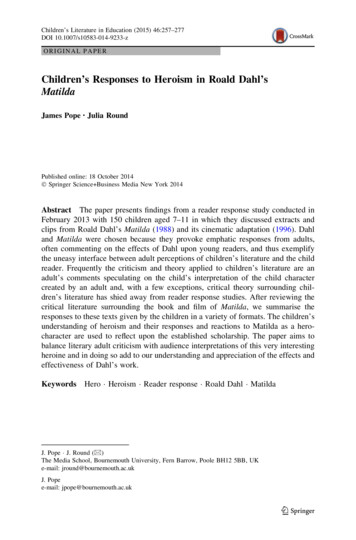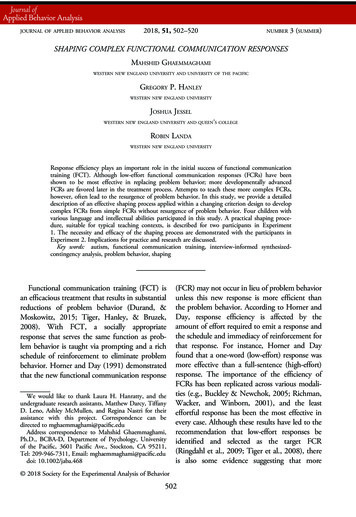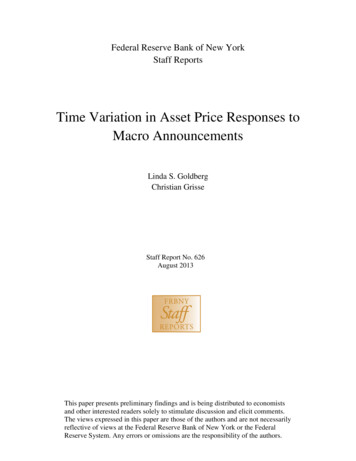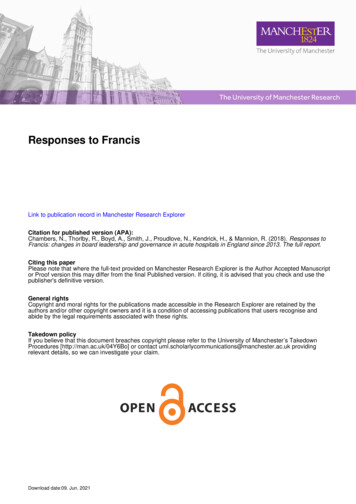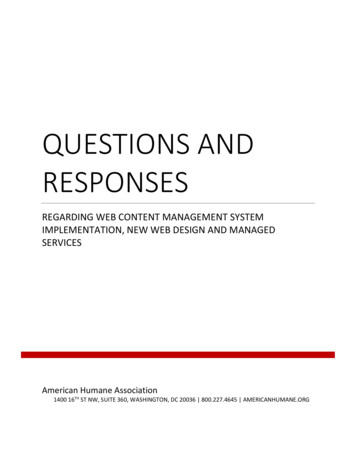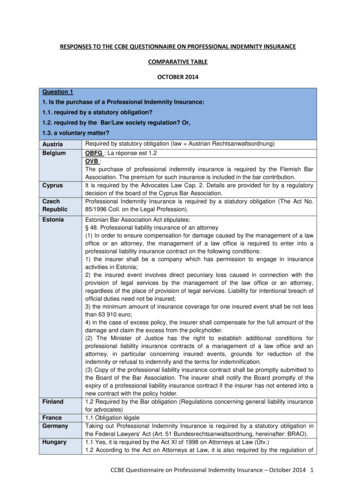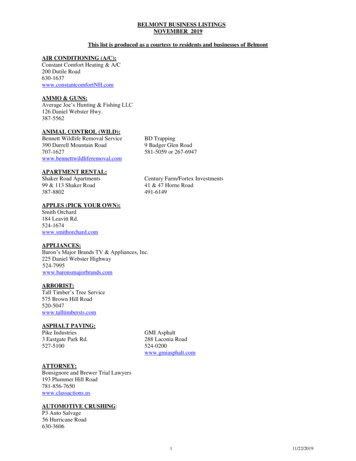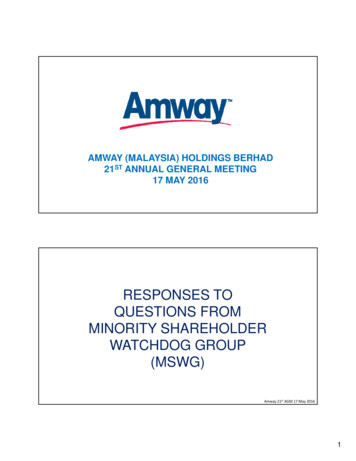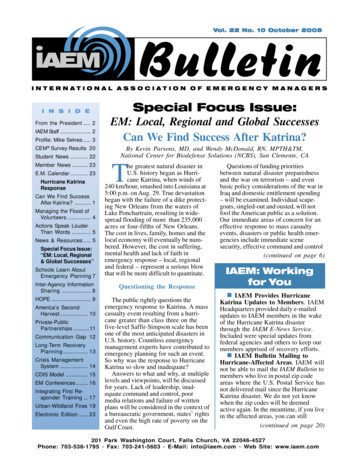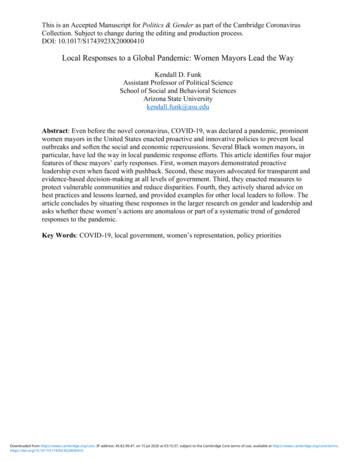
Transcription
This is an Accepted Manuscript for Politics & Gender as part of the Cambridge CoronavirusCollection. Subject to change during the editing and production process.DOI: 10.1017/S1743923X20000410Local Responses to a Global Pandemic: Women Mayors Lead the WayKendall D. FunkAssistant Professor of Political ScienceSchool of Social and Behavioral SciencesArizona State Universitykendall.funk@asu.eduAbstract: Even before the novel coronavirus, COVID-19, was declared a pandemic, prominentwomen mayors in the United States enacted proactive and innovative policies to prevent localoutbreaks and soften the social and economic repercussions. Several Black women mayors, inparticular, have led the way in local pandemic response efforts. This article identifies four majorfeatures of these mayors’ early responses. First, women mayors demonstrated proactiveleadership even when faced with pushback. Second, these mayors advocated for transparent andevidence-based decision-making at all levels of government. Third, they enacted measures toprotect vulnerable communities and reduce disparities. Fourth, they actively shared advice onbest practices and lessons learned, and provided examples for other local leaders to follow. Thearticle concludes by situating these responses in the larger research on gender and leadership andasks whether these women’s actions are anomalous or part of a systematic trend of genderedresponses to the pandemic.Key Words: COVID-19, local government, women’s representation, policy prioritiesDownloaded from https://www.cambridge.org/core. IP address: 45.82.99.47, on 15 Jul 2020 at 03:15:37, subject to the Cambridge Core terms of use, available at rg/10.1017/S1743923X20000410
When the World Health Organization declared COVID-19 a pandemic in March 2020, theUnited States federal government did little to stymie the virus’s spread. Several subnationalgovernments, however, responded quickly. Among those leading the way in response efforts arewomen mayors (Dittmar 2020). Several Black women mayors in particular, including SanFrancisco Mayor London Breed, Chicago Mayor Lori Lightfoot, and Atlanta Mayor KeishaLance Bottoms, have demonstrated remarkable leadership and ingenuity. These women mayorsand others have not only provided leadership for their cities, but also serve as role models forother leaders to follow.This article uses hypothesis-generating case studies (Levy 2008) of Democratic womenmayors of large U.S. cities to theorize about potential systematic gendered responses to thepandemic. While these women may represent “extreme” cases (Seawright and Gerring 2008)given the underrepresentation of women, especially women of color, among U.S. mayors, thefinal section offers theoretical reasons why other women mayors may produce similar responsesto the women featured here.A focus on local governments is prudent as governors begin to reopen states and publichealth experts warn local hotspots will emerge. Elected mayors and other local officials canimplement policies to prevent local outbreaks and soften the pandemic’s social and economicfallouts. Examining mayors’ early responses to COVID-19 can provide an indication of howlocal leaders might—or should—respond in the future and whether gender might affect theirresponses.Four major features stand out among these women mayors’ responses. First, theydemonstrated proactive leadership by quickly implementing preventative measures even as theyreceived pushback from various stakeholders. Second, their decisions were transparent,2Downloaded from https://www.cambridge.org/core. IP address: 45.82.99.47, on 15 Jul 2020 at 03:15:37, subject to the Cambridge Core terms of use, available at rg/10.1017/S1743923X20000410
evidence-based, and effectively communicated with the public. Third, they sought to not onlyprevent outbreaks, but also protect vulnerable communities and reduce disparities. Fourth, theywere generous in sharing best practices and lessons learned, providing models for others toemulate.Proactive LeadershipIn an interview with Glamour, San Francisco Mayor Breed said she realized the seriousness ofCOVID-19 in January (Kahn 2020). Following her realization, Breed acted quickly. She declareda state of emergency before a single case had been confirmed in San Francisco. She banned largegatherings in early March, effectively ending major sports. Shortly thereafter, she issued acitywide shelter-in-place order. Breed’s early actions were criticized as overreaching andalarmist (Kahn 2020), but her swift actions doubtlessly prevented many deaths (Berman 2020).Chicago Mayor Lightfoot and Atlanta Mayor Bottoms echoed Breed’s impulse for action.In the same interview with Glamour, Lightfoot admonished “I’m a Black woman in America.Nobody’s coming to rescue me. I’ve got to get it for myself, and I feel the same way with whatwe need to do here in our city;” while Bottoms urged “We’ve got to be prepared for thisregardless of what the federal preparations and the state preparations will be” (Kahn 2020).These women mayors are not the only ones who responded proactively when federal andstate responses seemed inadequate. Arizonan women mayors, including Tucson’s ReginaRomero, Phoenix’s Kate Gallego, and Flagstaff’s Coral Evans, implemented preventativemeasures weeks before Arizona’s governor issued a statewide stay-at-home order. These mayorsthen pushed back on the governor’s order for being too lax (Hassan 2020), to which he3Downloaded from https://www.cambridge.org/core. IP address: 45.82.99.47, on 15 Jul 2020 at 03:15:37, subject to the Cambridge Core terms of use, available at rg/10.1017/S1743923X20000410
responded with an Executive Order prohibiting local governments from closing businesses hedeemed essential.Transparent and Evidence-Based DecisionsWomen mayors have also advocated for transparent, evidence-based decision-making. WhenSeattle became an early epicenter in the U.S., Mayor Jenny Durkan was transparent with herconstituents. She reasoned “People are scared, confused, and getting mixed messages from thenational and local level. I think people will trust their local leaders. You have to be transparentabout the seriousness of the situation.” (Bloomberg Harvard 2020). While the majority of thecountry was proceeding with business as usual, Durkan restricted large gatherings and engagedSeattle’s research community to ramp up testing and modeling (Durkan 2020).In Arizona, when the statewide stay-at-home order was set to expire, Mayors Romero,Gallego, and Evans issued a statement urging the governor to follow all Center for DiseaseControl guidelines and present clear data showing a decline in cases before reopening the state.Even more recently, Mayor LaToya Cantrell has stated that New Orleans will not enter “PhaseTwo” of reopening along with the rest of Louisiana. Cantrell explains her decision, stating “weare watching the data, not the date. We don’t yet have sufficient data to authorize opening upfurther at this point. All of our decisions must be grounded in science ” (City of New OrleansMayor’s Office 2020).Vulnerable CommunitiesWomen mayors have also expressed concerns over how the pandemic will affect vulnerablecommunities and exacerbate existing inequalities. Atlanta Mayor Bottoms asked herself “Who is4Downloaded from https://www.cambridge.org/core. IP address: 45.82.99.47, on 15 Jul 2020 at 03:15:37, subject to the Cambridge Core terms of use, available at rg/10.1017/S1743923X20000410
going to be the most vulnerable? What will their needs be?” (Kahn 2020). These are questionsother women mayors seem to be asking—and answering—as well.In a letter to congressional leaders, the African American Mayors Association warned thepandemic will produce racial disparities (Owens 2020). This warning became a reality inChicago, where Black residents comprise a disproportionate share of COVID-19 cases anddeaths (Wetli 2020). Mayor Lightfoot deemed these disparities “unacceptable” (Wetli 2020), andresponded by adapting public transit, requiring healthcare providers to report demographic datawith COVID-19 testing, and deploying a Racial Equity Rapid Response Team. In similarfashion, Tucson Mayor Romero established the Somos Uno Resilience Fund to provide resourcesto members of the Latinx community regardless of their immigration status (Arce 2020).Securing food and shelter for vulnerable communities and childcare for essential workerswas also integrated into their response plans. Breed and Durkan quickly issued moratoriums onevictions (Berman 2020; Durkan 2020). Breed increased shelter capacity to facilitate socialdistancing among San Francisco’s homeless population (Berman 2020). Durkan, along withBottoms and Cantrell, initiated programs to address food insecurity (Dittmar 2020; Kahn 2020).Durkan, Breed, and Lightfoot also launched childcare programs for essential workers (Dittmar2020; Kahn 2020).Sharing Best PracticesEarly innovators, notably Durkan and Breed, have been generous to share their best practices andlessons learned. After managing Seattle’s early outbreaks, Durkan wrote an op-ed for theWashington Post advising other mayors to act quickly, be transparent and honest, engage theirresearch community, and anticipate outbreaks in vulnerable communities (Durkan 2020). Breed,5Downloaded from https://www.cambridge.org/core. IP address: 45.82.99.47, on 15 Jul 2020 at 03:15:37, subject to the Cambridge Core terms of use, available at rg/10.1017/S1743923X20000410
meanwhile, shared her policies and resources with other cities, explaining “As soon as someoneasks, we send it. We’re here to help” (Kahn 2020). Cities nationwide have replicated Breed’sinnovative policies, from her rigorous shelter-in-place order to the fee cap on delivery services.Atlanta Mayor Bottoms confirms she watched Breed and reproduced Breed’s stay-at-home order“almost word for word” (Kahn 2020).Indeed, these women mayors have produced national models of effective pandemicresponses. Among the first cities listed in the U.S. Conference of Mayors’ “City Guidelines andBest Practices” for COVID-19 are San Francisco, Seattle, Chicago, and Atlanta.1Are Proactive and Innovative Women Mayors Anomalies?Are these women anomalies or part of a systematic trend? While not all women mayors havedemonstrated praiseworthy leadership—Las Vegas Mayor Carolyn Goodman, for example,offered her city as a “control group”—there are several reasons why other women mayors mightact similarly to the ones highlighted here.2Research finds women tend to be more risk averse (Byrnes, Miller, and Schafer 1999),supportive of government intervention (Schlesinger and Heldman 2001), and prioritize socialpolicy to a greater extent than men (Barnes, Beall, and Holman forthcoming; Funk and Philips2019). If women are hesitant to risk overrunning hospitals, prioritize healthcare over economicinterests, and view government intervention favorably, then these characteristics might helpexplain women mayors’ proactive shutdown decisions.1See https://www.usmayors.org/issues/covid-19/. Last accessed on July 3, 2020.2Carolyn Goodman interview with Anderson Cooper on CNN on April 22, 2020. Available px.cnn.6Downloaded from https://www.cambridge.org/core. IP address: 45.82.99.47, on 15 Jul 2020 at 03:15:37, subject to the Cambridge Core terms of use, available at rg/10.1017/S1743923X20000410
There is also evidence that women mayors increase municipal transparency (Araujo andTejedo-Romero 2018) and at least two reasons why they may support evidence-based healthcarepolicies. First, women politicians are more likely to have experience in the healthcare sector andthis can factor into policy decisions (Barnes, Beall, and Holman forthcoming). Second, womenare more likely to acknowledge limitations in their qualifications (Fox and Lawless 2011) andthus may be more likely to seek outside expertise to inform decisions.Women’s greater emphasis on social issues (Barnes, Beall, and Holman forthcoming;Funk and Philips 2019) might also explain why these mayors’ response plans included socialprotections. And, combining insights from research on policy diffusion (Einstein, Glick, andPalmer 2019) and political role models (Stokes-Brown and Dolan 2010) suggests women mayorsmay look to one another for guidance. Thus, other women mayors may model their pandemicresponses after these innovative leaders.Finally, we must also acknowledge the role of intersectionality, and especially howpartisanship and race factor into women mayors’ responses. Partisanship is major determinant ofCOVID-19 responses in the U.S. (Adolph et al. 2020), and the responses of non-Democraticwomen mayors have been notably less commendable than their Democratic counterparts. Thewomen featured in this article are also trailblazers; often the first Black woman or lesbianwoman to be elected mayor. The responses of Black women politicians, in particular, might beunique given their hypervisibility, progressiveness, and prioritization of “intersectionallymarginalized populations” (Brown and Banks 2014). Thus, it is incumbent on future research todetermine whether other women of color, White women, and conservative women leaders acrosscontexts have also responded in proactive, transparent, evidence-based, and socially-mindedways or whether these women mayors are truly anomalies.7Downloaded from https://www.cambridge.org/core. IP address: 45.82.99.47, on 15 Jul 2020 at 03:15:37, subject to the Cambridge Core terms of use, available at rg/10.1017/S1743923X20000410
ReferencesAdolph, Christopher, et al. 2020. “Pandemic Politics: Timing State-Level Social DistancingResponses to COVID-19.” medRxiv. DOI: 10.1101/2020.03.30.20046326.Araujo, Joaquim Filipe Ferraz Esteves, and Francisca Tejedo-Romero. 2018. "Does genderequality affect municipal transparency: The case of Spain." Public Performance &Management Review 41(1): 69-99.Arce, Javier. 2020. “Mayors of Tucson, Los Angeles urge federal government for more help forLatinos.” AZ Central, May re-help-latinos-coronavirus/5202449002/.Barnes, Tiffany D., Victoria D. Beall, and Mirya R. Holman. Forthcoming. “Pink-CollarRepresentation and Budgetary Outcomes in US States.” Legislative Studies Quarterly.DOI: 10.1111/lsq.12286.Berman, Russell. 2020. “The City That Has Flattened the Coronavirus Curve.” The Atlantic,April 12. loomberg Harvard. 2020. “Q&A with Seattle Mayor Jenny Durkan: On the Front Lines sinceJanuary, Seattle Mayor Shares Her Take on Responding to an Outbreak.” BloombergHarvard City Leadership Initiative, March rkan-qa.Brown, Nadia and Kira Hudson Banks. 2014. “Black Women’s Agenda Setting in the MarylandState Legislature.” Journal of African American Studies 18(2): 164-180.8Downloaded from https://www.cambridge.org/core. IP address: 45.82.99.47, on 15 Jul 2020 at 03:15:37, subject to the Cambridge Core terms of use, available at rg/10.1017/S1743923X20000410
Byrnes, James P., David C. Miller, and William D. Schafer. 1999. "Gender differences in risktaking: a meta-analysis." Psychological Bulletin 125(3): 367-383.City of New Orleans Mayor’s Office. 2020. “Orleans Parish Monitoring Data Closely, WillRemain Under ‘Phase One’ Guidelines Beyond June 5.” June se-one-guidelines-beyond-june-5/.Dittmar, Kelly. 2020. “Women on the Front Lines in Cities’ Fights Against COVID-19.” Centerfor American Women and Politics, April 14. n-mayors-covid-19.Durkan, Jenny. 2020. “What every mayor needs to know about this virus.” Washington Post,March 14. /seattle-mayor-jennydurkan-coronavirus/.Einstein, Katherine Levine, David M. Glick, and Maxwell Palmer. 2019. "City learning:Evidence of policy information diffusion from a survey of US mayors." PoliticalResearch Quarterly 72(1): 243-258.Fox, Richard L., and Jennifer L. Lawless. 2011. "Gendered perceptions and political candidacies:A central barrier to women's equality in electoral politics." American Journal of PoliticalScience 55(1): 59-73.Funk, Kendall D., and Andrew Q. Philips. 2019. "Representative budgeting: Women mayors andthe composition of spending in local governments." Political Research Quarterly 72(1):19-33.Hassan, Anita. 2020. “Arizona mayors slam COVID-19 stay-at-home order that allows hairsalons, golf courses to remain open.” NBC News, April 1.9Downloaded from https://www.cambridge.org/core. IP address: 45.82.99.47, on 15 Jul 2020 at 03:15:37, subject to the Cambridge Core terms of use, available at rg/10.1017/S1743923X20000410
6.Kahn, Mattie. 2020. “The Women Leading the Coronavirus Response from City Hall.” Glamour,May 4. -the-coronavirusresponse.Levy, Jack S. 2008. “Case Studies: Types, Designs, and Logics of Inference.” ConflictManagement and Peace Science 25: 1-18.Owens, Donna M. 2020. “Black Mayors Warn COVID-19 Could Hit Our CommunitiesEspecially Hard.” Essence, April 6. 19/.Schlesinger, Mark, and Caroline Heldman. 2001. "Gender gap or gender gaps? New perspectiveson support for government action and policies." Journal of Politics 63(1): 59-92.Seawright, Jason and John Gerring. 2008. “Case Selection Techniques in Case Study Research.”Political Research Quarterly 61(2): 294-308.Stokes‐Brown, Atiya Kai, and Kathleen Dolan. "Race, gender, and symbolic representation:African American female candidates as mobilizing agents." Journal of Elections, PublicOpinion and Parties 20.4 (2010): 473-494.Wetli, Patty. 2020. “Lightfoot Activates Rapid Response Team to Stem ‘Unacceptable’ RacialDisparity in COVID-19 Deaths.” WTTW News, April isparity-covid-19.10Downloaded from https://www.cambridge.org/core. IP address: 45.82.99.47, on 15 Jul 2020 at 03:15:37, subject to the Cambridge Core terms of use, available at rg/10.1017/S1743923X20000410
Arizona State University kendall.funk@asu.edu Abstract: Even before the novel coronavirus, . (Stokes-B

